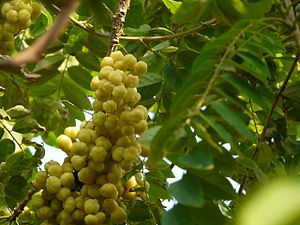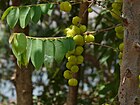Note: This is a project under development. The articles on this wiki are just being initiated and broadly incomplete. You can Help creating new pages.
Phyllanthus distichus
Phyllanthus distichus is a species of flowering plant in the family Phyllanthaceae. It ia native to the Hawaiian Islands.
Uses
Parts Used
Chemical Composition
These fruits are reputed to contain high amounts of ascorbic acid (vitamin C), and have bitter taste that may derive from a high density of ellagitannins etc.[1]
Common names
| Language | Common name |
|---|---|
| Kannada | Betta nelli, Amalaka |
| Hindi | आँवला Aonla |
| Malayalam | Nelli, Nellikka |
| Tamil | Nelli |
| Telugu | Usiri, Usirikaya |
| Marathi | NA |
| Gujarathi | NA |
| Punjabi | NA |
| Kashmiri | NA |
| Sanskrit | Dhatri, amalaka |
| English | Amla, Indian gooseberry |
Properties
Reference: Dravya - Substance, Rasa - Taste, Guna - Qualities, Veerya - Potency, Vipaka - Post-digesion effect, Karma - Pharmacological activity, Prabhava - Therepeutics.
Dravya
Rasa
Guna
Veerya
Cold(Sheeta)
Vipaka
Karma
Prabhava
Habit
Identification
Leaf
| Kind | Shape | Feature |
|---|---|---|
| Simple | Round in outline | 10–20 cm (3.9–7.9 in) long subsessile and closely set along branchlets, light green, resembling pinnate leaves. |
Flower
| Type | Size | Color and composition | Stamen | More information |
|---|---|---|---|---|
| Bisexual | Greenish-yellow |
Fruit
| Type | Size | Mass | Appearance | Seeds | More information |
|---|---|---|---|---|---|
| Simple Fruit | Spherical | Smooth and hard on appearance, with six vertical stripes or furrows. | Light greenish-yellow | {{{6}}} |
Other features
List of Ayurvedic medicine in which the herb is used
Where to get the saplings
Mode of Propagation
How to plant/cultivate
A plant mainly of the hot, tropical lowlands, succeeding in both humid and semi-arid areas. It can also be found at elevations up to 2,300 metres in southern China. It grows best in areas where annual daytime temperatures are within the range 20 - 29°c, but can tolerate 14 - 35°c. It prefers a mean annual rainfall in the range 1,500 - 2,500mm, but tolerates 700 - 4,200mm.[3]
Commonly seen growing in areas
Photo Gallery
References
External Links
- Ayurvedic Herbs known to be helpful to treat Diabetes
- Ayurvedic Herbs known to be helpful to treat Fever
- Herbs with Fruits used in medicine
- Herbs with Leaves used in medicine
- Herbs with common name in Kannada
- Herbs with common name in Hindi
- Herbs with common name in Malayalam
- Herbs with common name in Tamil
- Herbs with common name in Telugu
- Herbs with common name in Sanskrit
- Herbs with common name in English
- Habit - Tree
- Index of Plants which can be propagated by Seeds
- Herbs that are commonly seen in the region of Lowland forest
- Herbs
- Phyllanthaceae


